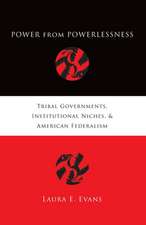Tourism and Indigenous Peoples
Autor Richard Butler, Tom Hinchen Limba Engleză Paperback – 25 sep 2007
First published over ten years ago the editors, Butler and Hinch, have thoroughly revised and updated the text to bring together a new collection of contributions and case studies from recognised international authors and those with first hand experiences in this area. Divided into five main sections, the text looks at this topic under the following headings:
* Involvement: Uses case studies to discuss and compare such as ‘campfire’ programmes in east Africa, and the employment of indigenous peoples as guides, amongst other cases,
* Turbulence: Host guest relationships, conflicts on communities and contrasting strategies and results of tourism in indigenous villages in South Africa
* Issues: Discusses issues such as authenticity, religious beliefs and managing indigenous tourism in a fragile environment
* Progress: Looks at tourism education, tourism and cultural survival and examples of the policy and practice of indigenous tourism.
* Conclusions: Five contributions from indigenous people on North America, Australasia and Europe to discuss implications and experiences.
Each section uses international case studies from, for example, Australia, New Zealand, Nepal, Namibia, Thailand, Saudi Arabia and South America.
| Toate formatele și edițiile | Preț | Express |
|---|---|---|
| Paperback (1) | 468.00 lei 6-8 săpt. | |
| Taylor & Francis – 25 sep 2007 | 468.00 lei 6-8 săpt. | |
| Hardback (1) | 1163.63 lei 6-8 săpt. | |
| Taylor & Francis – 2 noi 2015 | 1163.63 lei 6-8 săpt. |
Preț: 468.00 lei
Preț vechi: 550.59 lei
-15% Nou
Puncte Express: 702
Preț estimativ în valută:
89.58€ • 97.34$ • 75.30£
89.58€ • 97.34$ • 75.30£
Carte tipărită la comandă
Livrare economică 22 aprilie-06 mai
Preluare comenzi: 021 569.72.76
Specificații
ISBN-13: 9780750664462
ISBN-10: 0750664460
Pagini: 400
Ilustrații: Illustrated
Dimensiuni: 156 x 234 x 24 mm
Greutate: 0.65 kg
Ediția:1
Editura: Taylor & Francis
Colecția Routledge
Locul publicării:Oxford, United Kingdom
ISBN-10: 0750664460
Pagini: 400
Ilustrații: Illustrated
Dimensiuni: 156 x 234 x 24 mm
Greutate: 0.65 kg
Ediția:1
Editura: Taylor & Francis
Colecția Routledge
Locul publicării:Oxford, United Kingdom
Public țintă
Senior undergraduates and post graduates in tourism, also business, anthropology, geography and development programmes. Supplementary reading for courses such as: Sustainable Development, Sustainable Tourism, Interpretation and specific indigenous tourism courses.Public sector agencies, NGOs, to indigenous groups, and to the private sector concerned with tourism development in conjunction with indigenous peoples.
Cuprins
Introduction - Local indigenous ecological knowledge and tourism; Involvement - Tourism development and the Little Red River Cree; ‘Campfire’ programmes in East Africa; Sami involvement in winter festivals; Planned community control; Indigenous tourism involvement in the American west; Employment of indigenous peoples as guides; Turbulence - Conflict in Chinese rural communities over tourism; Contrasting strategies and results of tourism development in indigenous villages in south America; Haida watchman programme; Host-guest relationships with the Dene Nation; Issues - Authenticity of indigenous offerings and tourism; Maori image and identity with tourism; Thai village experiences; Accommodating Muslim beliefs in tourism development; Managing indigenous tourism in a fragile environment; Progress - Reservations, indigenous peoples and gambling; Marketing Australian aboriginal tourism; Tourism education for indigenous peoples; Tourism, Maoris and national parks; Development of indigenous tourism by policy and practice in Australia; Tourism and cultural survival; Conclusions - Indigenous voices; Conclusions and implications.
Descriere
Tourism and Indigenous Peoples is a unique text examining the role of indigenous societies in tourism and how they interact within the tourism nexus. Unlike other publications, this text focuses on the active role that indigenous peoples take in the industry, and uses international case studies and experiences to provide a global context to illustrate best practice and aid comparison.
First published over ten years ago the editors, Butler and Hinch, have thoroughly revised and updated the text to bring together a new collection of contributions and case studies from recognised international authors and those with first hand experiences in this area. Divided into five main sections, the text looks at this topic under the following headings:
* Involvement: Uses case studies to discuss and compare such as ‘campfire’ programmes in east Africa, and the employment of indigenous peoples as guides, amongst other cases,
* Turbulence: Host guest relationships, conflicts on communities and contrasting strategies and results of tourism in indigenous villages in South Africa
* Issues: Discusses issues such as authenticity, religious beliefs and managing indigenous tourism in a fragile environment
* Progress: Looks at tourism education, tourism and cultural survival and examples of the policy and practice of indigenous tourism.
* Conclusions: Five contributions from indigenous people on North America, Australasia and Europe to discuss implications and experiences.
Each section uses international case studies from, for example, Australia, New Zealand, Nepal, Namibia, Thailand, Saudi Arabia and South America.
First published over ten years ago the editors, Butler and Hinch, have thoroughly revised and updated the text to bring together a new collection of contributions and case studies from recognised international authors and those with first hand experiences in this area. Divided into five main sections, the text looks at this topic under the following headings:
* Involvement: Uses case studies to discuss and compare such as ‘campfire’ programmes in east Africa, and the employment of indigenous peoples as guides, amongst other cases,
* Turbulence: Host guest relationships, conflicts on communities and contrasting strategies and results of tourism in indigenous villages in South Africa
* Issues: Discusses issues such as authenticity, religious beliefs and managing indigenous tourism in a fragile environment
* Progress: Looks at tourism education, tourism and cultural survival and examples of the policy and practice of indigenous tourism.
* Conclusions: Five contributions from indigenous people on North America, Australasia and Europe to discuss implications and experiences.
Each section uses international case studies from, for example, Australia, New Zealand, Nepal, Namibia, Thailand, Saudi Arabia and South America.














